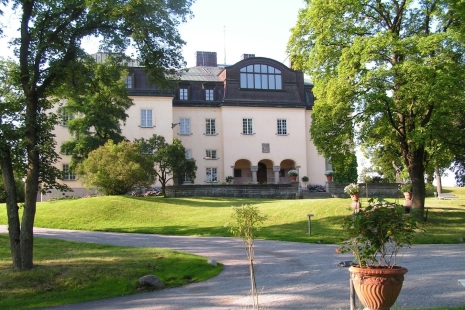The exhibition Hertervig – Hill. Dream and Reality is the first major presentation of Lars Hertervig’s art in Sweden and the most extensive exhibition of his work outside of Norway. The presentation includes around 150 works (approx. 75 by each artist) and aims to create a dialogue between Lars Hertervig’s and Carl Fredrik Hill’s art and to highlight the unique and common aspects of their artistic activities. The selection of works covers much of their output, with a particular focus on the more visionary and spiritual works that were added during the late phases of their lives. These works, which can be seen as an extension of late Romanticism and Symbolism as well as a precursor to Surrealism, highlight both parallels and differences between the two artists.
Both Hertervig and Hill suffered from mental illness that affected their ability to participate in official art life, giving them unusual artistic freedom. They both developed their own distinctive artistic expressions and followed their own interests in the choice of motifs and themes. This is perhaps also why Hertervig’s and Hill’s art has always been of great interest to other artists, writers, playwrights and musicians.
Curators for Hertervig – Hill. Dream and reality are Karin Sidén (museum director of Prins Eugen’s Waldemarsudde), Hanne Beate Ueland (department director at Stavanger Kunstmuseum) and Knut Ljøgodt (director of the Nordic Institute of Art). The exhibition is organized in collaboration with Stavanger Kunstmuseum and the Nordic Institute of Art.
A number of special events, such as lectures, talks, screenings and concerts, will also be arranged. We end the exhibition period in mid-January by showing a number of works by the artist Maria Hall in the Bernadotte room, which in different ways engage in a dialogue with both Hill’s and Hertervig’s artistry.
Lars Hertervig (1830–1902) grew up on the island of Borgøy on Norway’s southwest coast off Stavanger; a landscape that became a recurring theme in his art. After attending the Royal Academy of Drawing in Oslo, he continued to Düsseldorf in the early 1850s as a student of the Norwegian professor Hans Gude at the Düsseldorf Art Academy. Tragically, Hertervig fell ill and returned to Norway, where he himself saw to it that he was admitted for a period to the Gaustad mental hospital outside Oslo. He spent the rest of Hertervig’s life in his home areas on Borgøy and in Stavanger, where he worked in relative isolation and with limited means. In the 1860s and 70s he painted a series of striking landscapes in both oil and watercolour; some show a fascination with decay while others are more contemplative. These works can be seen as the artist’s visions of nature, sometimes possibly based on vague memories of a specific landscape.
Carl Fredrik Hill (1849–1911) was born in Lund in southern Sweden. After studying at the Art Academy in Stockholm, specializing as a landscape painter, he lived in Paris for several years during the 1870s. Influenced by i.a. Camille Corot painted Hill – like many other Nordic artists – plein air studies at Barbizon and other popular locations outside Paris. His early works reflect the ideals of realistic flow and plein air painting. In January 1878, Hill was admitted to an institution for the mentally ill in Passy, France, and then to Sct Hans hospital in Roskilde and to Sankt Lars in Lund, where he stayed until 1883. For the last three decades of his life, Hill lived with his family in his childhood home in Lund. The artist continued to draw and paint, above all on paper. He continued to depict landscapes, which now took on a more visionary character, sometimes relating to his early work. He also drew figures, palace interiors, animals and imaginary creatures. These expressive works often have the character of dreams or visions.





